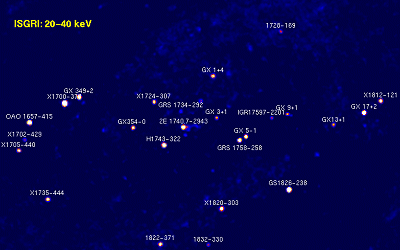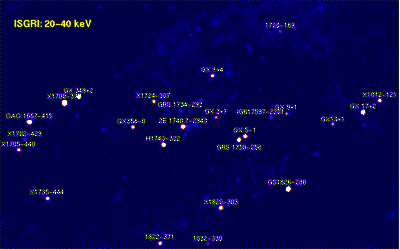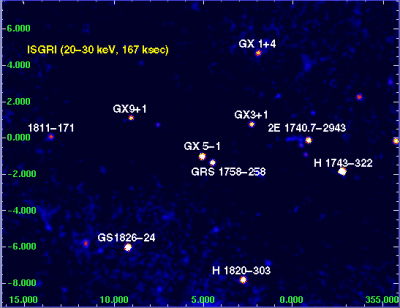INTEGRAL Observations of the Galactic Centre Region
25 May 2005
Integral continues to observe the X-ray and gamma-ray emission from the galactic centre region. These observations at the high-energy end of the electromagnetic spectrum contribute to our knowledge of the physical processes at play and the type of objects residing at the centre of our Milky Way.Below are two images and an animation of the galactic centre, released last week by the INTEGRAL Science Data Centre (ISDC). The observations were made with the IBIS/ISGRI instrument that is capable of detecting emission in the range 15 keV - 10 MeV.
 |
|
Credits: A. Paizis (ISDC, Geneva & IASF/CNR, Milano) |
IBIS/ISGRI mosaic of the Galactic Centre region (20-40 keV, 5.7 Msec). Only the main sources are labelled for clarity. The majority of the visible sources are Low Mass X-ray Binaries (LMXRBs). In these objects, the physical process at the origin of the production of such energetic X-rays is inverse Comptonisation of soft seed photons (from the accretion disc and/or neutron star surface) by a hot plasma present in the system (for example accretion disc corona, neutron star boundary layer, accelerated particles in jets).
Publication: Paizis et al., 2004, Proceedings of the 5th INTEGRAL Workshop "The INTEGRAL Universe".
 |
|
Credits: A. Paizis (ISDC, Geneva & IASF/CNR, Milano) |
Animation of four IBIS/ISGRI mosaic images of the galactic centre region in four different energy bands: 20-40 keV, 40-60 keV, 60-80 keV and 80-100 keV. The sources become dimmer and dimmer at higher energies because the number of photons they release decreases from the lower energy X-rays to the higher energy gamma-rays. The total exposure time is of 5.7 Msec. The main sources are labelled in the lowest energy (20-40 keV) image. The majority of the visible sources are LMXRBs.
Publication: Paizis et al., 2004, Proceedings of the 5th INTEGRAL Workshop "The INTEGRAL Universe".
 |
|
Credits: A. Paizis (ISDC, Geneva & IASF/CNR, Milano) |
IBIS/ISGRI mosaic image of the galactic centre region around GX 5-1. Thanks to the high imaging capability (angular resolution) of INTEGRAL, it for the first time is possible to disentangle the hard X-ray emission of the neutron star low mass X-ray binary GX 5-1 (centre of the image), from the nearby black hole candidate GRS 1758-258 (40 arcmin away). Ada Paizis and the co-authors of a recent article submitted to the Astronomy & Astrophysics journal interpret the hard X-ray emission from GX 5-1 as Compton up-scattering of soft photons from the neutron star surface due to a thin hot plasma expected in the boundary layer.
Publication: Paizis et al., 2005, A&A, submitted.

